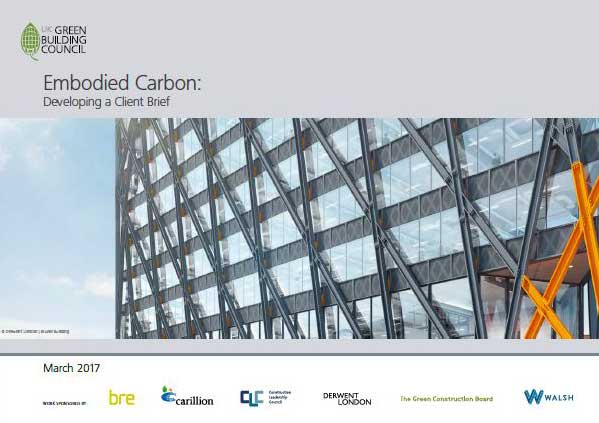In recent years construction industry clients have achieved significant reductions in the operational energy used by structures, thereby reducing carbon emissions. The next challenge is to reduce the carbon intensity of the structures themselves.
 Understanding embodied carbon measurements as early as possible on a project is crucial to making energy-efficient choices throughout the project lifecycle.
Understanding embodied carbon measurements as early as possible on a project is crucial to making energy-efficient choices throughout the project lifecycle.
With that aim in mind the UK Green Building Council (UK-GBC) has recently developed a guide, Embodied Carbon: Developing a Client Brief, designed to help built environment clients start requesting embodied carbon measurements. The guidance includes understanding the outcomes from an assessment and how to start acting on the results.
The guidance explains some of the basics of embodied carbon and gives an overview of some suggested approaches. It also provides example wording - which is designed to help clients stipulate the requirements for an embodied carbon measurement.
Embodied Carbon is the hidden prize in shaping a better built environment
David Picton, Carillion
By the end of the guidance users should have a good overview of embodied carbon and be able to write a clear brief to commission an embodied carbon measurement.
Julie Hirigoyen, Chief Executive at UK-GBC believes the time is right for the industry to make strides on embodied carbon. "As operational carbon reduces, the relative significance of embodied carbon increases. So we will continue to advocate for embodied carbon to become a mainstream issue in building design, construction and maintenance. Indeed, we will be encouraging our client members and other clients in the industry to create their own embodied carbon briefs by making effective use of this guidance," she said.
The view is echoed by Carillion's David Picton. “Measuring, tackling and reducing embodied carbon is the hidden prize in shaping a better built environment – as an integrated services and construction company we hope this guidance will drive clients, designers, contractors and suppliers to work side by side to develop and maintain infrastructure with the lowest possible carbon content. For tomorrow, 2030 and beyond, this has to be inextricably linked with operational carbon reductions as the only way to tackle our global climate challenge,” he said.How should a client brief for embodied carbon assessment be structured?
Embodied Carbon: Developing a Client Brief from the UK Green Building Council sets out an example client brief for commissioning an embodied carbon assessment. It recommends a document structured along the following lines:
Context and company objectives
Thie section should set out the need for an embodied carbon assessment. This may include focus on company-specific context, general sustainability objectives and overall carbon aims. Previous experience in embodied carbon measurement and reduction may also be usefully highlighted here. The fundamental aim is to make clear the drivers for commissioning an assessment and the objectives for the data being collated.
Boundary
The brief should set out the most appropriate boundary for the organisation's interests and future planning.
Scope of the assessment
Will the assessment apply at project, asset or activity level? Details on which project activities are included and excluded from the calculation should be made clear.
Assessment standards and calculation methodology
The brief should make clear which standards and calculation methodologies should be used in the assessement. Calculation methodology could be the assessor's own or the RICS Methodology. Calculations not using the standards and methodologies outlines should be justified and explained by the assessor.
Data and tools
The client should outline which embodied carbon data, databases and calculation tools are
Starting point, iterations and frequency
At what stage in the project will the assessment take place and how will this evolved across the project lifecycle? The earlier the assessment is carried out the more opportunities for
Presenting the results
Details of how the assessment will be presented and assumptions made along the way. Details as to how the results should be broken down (and to what level) will help inform decisions at later project stages and on future projects.
The client may wish to consider requesting a list of reduction strategy targets (For example, the top five suggestions for reducing embodied carbon impact, with reasoning). Alternatively, recommendations could be made on a materials used in elements and components basis, or on the reductions achievable in each stage of a project.
Related articles on theNBS.com
Embodied Carbon Emissions of Construction Materials
This video programme aims to help those who wish to understand more about how the environmental performance of construction products should be calculated.


